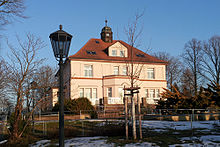Radeberg Botanical Garden for the Blind
The Botanical Blind Garden Radeberg is a botanical garden in the Saxon city of Radeberg , which is specially tailored to the needs of deaf-blind and blind people with multiple disabilities. The first botanical garden in German-speaking countries, which is completely designed as a garden for the blind , extends over 20,000 square meters around the meeting place of the deafblind service eV , the Villa Storchennest . The Botanical Garden for the Blind is a full member of the International Garden Therapy Society .
history
After the opening of the advice center of the deaf-blind service in 1993, the reconstruction of the overgrown, park-like area around the Villa Storchennest began. During the three-year construction phase, in addition to the landscape architecture , especially the blind and disabled-friendly aspects were promoted. The planting plan for the plant was developed under the direction of Prof. Gerhard Richter from the Institute for Open Space Planning at Weihenstephan-Triesdorf University .
On September 1, 1996, the facility was opened as the Radeberg Blind Garden by Hans Geisler , the then Saxon State Minister for Social Affairs, Health and Family . The garden initially had an area of 5,600 square meters. In the years 2000, 2003 and 2005 the garden area was expanded to a total of 20,000 square meters (in October 2005) through additions and acquisitions of neighboring properties. In 2002 the blind garden was accepted into the Association of Botanical Gardens and named the Botanical Blind Garden Radeberg. In 2003 the greenhouse facility on the Storchenaue opened .
garden
The barrier-free landscaped garden is provided with an approx. 1.5 kilometer long system of paths that can be used both on foot and with a wheelchair. A stainless steel handrail was erected along the main paths for orientation for blind and visually impaired visitors. Additional orientation aids (reliefs) are attached to this. The side paths are equipped with different types of flooring ( e.g. bark mulch , lawn or porphyry gravel ) to enable orientation with the feet. As control system this way have a knock edge , with the cane can be felt.
Around 1,300 different plant species grow in the Radeberg Botanical Blind Garden, including around 700 strongly fragrant ones. Especially small or low-growing species are planted in raised beds . In addition to olfactory perception , this makes it easier to grasp the plants with the sense of touch . The signs attached directly to the place of growth are provided with alphabet and Braille .
Separate areas were set up with particularly strong or unusually fragrant plant species, such as the mint garden , the chamomile path and the pelargonium collection . For example, so-called scented arbors are planted with various species of honeysuckle and wisteria . In the nursery of the blind garden there is also a collection of strongly scented potted plants . Along the paths there are touch and contact scents , i.e. plant species such as thyme , which only give off their scent when touched, were planted as a guide.
The Deafblindendienst eV organizes an open day and a garden party every year, but also regular seminars (for example herbal courses ) for blind and deaf-blind people. Various types of scented plants are available for purchase from the nursery and bazaar sales.
Fragrance house
In 2004 the nursery of the blind garden began with the establishment of a camellia collection . A greenhouse, the fragrance house on the Storchenaue , houses the camellia show. In addition to Pillnitz , zuschendorf , Königsbrück and Rosswein , the Radeberg blind garden became the fifth officially recognized Saxon camellia site. The collection focuses on strongly fragrant camellias.
Awards
In 2011 Ruth Zacharias , the then head of the facility and largely responsible for its construction and expansion, was honored with the Saxon Citizens' Prize. In 2013 she was awarded the Alma de l'Aigle Prize for Garden Culture for the Radeberger Blindengarten . The prize awarded by the Society for the Promotion of Garden Culture honors particularly sustainable projects and people in the field of garden culture.
See also
Web links
Individual evidence
- ↑ Bernd Goldammer, Jens Fritzsche: The special garden. In: Sächsische Zeitung , edition 5 September 2011
- ↑ List of members of the International Garden Therapy Society. Retrieved February 26, 2016 .
- ↑ Ruth Zacharias: The fragrant garden - Botanischer Blindengarten Storchennest. Brochure, 2nd revised and expanded edition, 2001
- ↑ Radeberg Botanical Garden for the Blind is 20 years old. Accessed June 25, 2018 (German).
- ↑ Overview of the Association of Botanical Gardens eV on the facilities in Germany. Retrieved August 29, 2014 .
- ↑ Ulrike Springer: Garden therapy: clinics and areas of application at www.wecarelife.at. Retrieved February 26, 2016 .
- ↑ Camellia awakens the feeling of spring in the cold winter. In: Sächsischer Bote, edition 05/2011.
- ↑ Alma de l'Aigle Prize. (No longer available online.) Society for the Promotion of Garden Culture eV, archived from the original on February 26, 2016 ; accessed on February 26, 2016 .
Coordinates: 51 ° 6 '18 " N , 13 ° 55' 21.8" E
